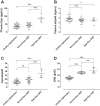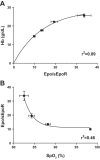Decreased plasma soluble erythropoietin receptor in high-altitude excessive erythrocytosis and Chronic Mountain Sickness
- PMID: 25324511
- PMCID: PMC4254844
- DOI: 10.1152/japplphysiol.00619.2014
Decreased plasma soluble erythropoietin receptor in high-altitude excessive erythrocytosis and Chronic Mountain Sickness
Abstract
Excessive erythrocytosis (EE) is the hallmark of chronic mountain sickness (CMS), a prevalent syndrome in high-altitude Andean populations. Although hypoxemia represents its underlying stimulus, why some individuals develop EE despite having altitude-normal blood erythropoietin (Epo) concentration is still unclear. A soluble form of the Epo receptor (sEpoR) has been identified in human blood and competes directly for Epo with its membrane counterpart (mEpoR). Thus, reduced levels of circulating sEpoR could lead to higher Epo availability and ultimately to EE. We characterized the relationship between Epo and sEpoR, with hematocrit and hemoglobin concentration in healthy highlanders and CMS patients at 4,340 m in Cerro de Pasco, Peru. Our results show that EE patients show decreased plasma sEpoR levels and can be subdivided into two subgroups of normal and high plasma Epo concentration for the altitude of residence, with hemoglobin concentration rising exponentially with an increasing Epo-to-sEpoR ratio (Epo/sEpoR). Also, we showed that the latter varies as an inverse exponential function of arterial pulse O2 saturation. Our findings suggests that EE is strongly associated with higher Epo/sEpoR values, leading to elevated plasma Epo availability to bind mEpoR, and thereby a stronger stimulus for augmented erythropoiesis. Differences in the altitude normal and high Epo CMS patients with a progressively higher Epo/sEpoR supports the hypothesis of the existence of two genetically different subgroups suffering from EE and possibly different degrees of adaptation to chronic high-altitude hypoxia.
Keywords: Chronic Mountain Sickness; erythropoietin; excessive erythrocytosis; high-altitude; soluble erythropoietin receptor.
Copyright © 2014 the American Physiological Society.
Figures


Similar articles
-
Plasma soluble erythropoietin receptor is decreased during sleep in Andean highlanders with Chronic Mountain Sickness.J Appl Physiol (1985). 2016 Jul 1;121(1):53-8. doi: 10.1152/japplphysiol.00107.2016. Epub 2016 Apr 28. J Appl Physiol (1985). 2016. PMID: 27125843 Free PMC article.
-
High-Altitude Hypoxia Decreases Plasma Erythropoietin Soluble Receptor Concentration in Lowlanders.High Alt Med Biol. 2020 Mar;21(1):92-98. doi: 10.1089/ham.2019.0118. Epub 2020 Jan 23. High Alt Med Biol. 2020. PMID: 31977247 Free PMC article.
-
Association between serum concentrations of hypoxia inducible factor responsive proteins and excessive erythrocytosis in high altitude Peru.High Alt Med Biol. 2015 Mar;16(1):26-33. doi: 10.1089/ham.2014.1086. Epub 2015 Mar 11. High Alt Med Biol. 2015. PMID: 25760230 Free PMC article.
-
New genetic and physiological factors for excessive erythrocytosis and Chronic Mountain Sickness.J Appl Physiol (1985). 2015 Dec 15;119(12):1481-6. doi: 10.1152/japplphysiol.00271.2015. Epub 2015 Aug 13. J Appl Physiol (1985). 2015. PMID: 26272318 Free PMC article. Review.
-
Higher androgen bioactivity is associated with excessive erythrocytosis and chronic mountain sickness in Andean Highlanders: a review.Andrologia. 2015 Sep;47(7):729-43. doi: 10.1111/and.12359. Epub 2014 Oct 3. Andrologia. 2015. PMID: 25277225 Review.
Cited by
-
High altitude polycythemia and its maladaptive mechanisms: an updated review.Front Med (Lausanne). 2024 Aug 27;11:1448654. doi: 10.3389/fmed.2024.1448654. eCollection 2024. Front Med (Lausanne). 2024. PMID: 39257892 Free PMC article. Review.
-
Erythropoietin Produces a Dual Effect on Carotid Body Chemoreception in Male Rats.Front Pharmacol. 2021 Sep 14;12:727326. doi: 10.3389/fphar.2021.727326. eCollection 2021. Front Pharmacol. 2021. PMID: 34594222 Free PMC article.
-
Plasma soluble erythropoietin receptor is decreased during sleep in Andean highlanders with Chronic Mountain Sickness.J Appl Physiol (1985). 2016 Jul 1;121(1):53-8. doi: 10.1152/japplphysiol.00107.2016. Epub 2016 Apr 28. J Appl Physiol (1985). 2016. PMID: 27125843 Free PMC article.
-
Hemoglobin Mass and Blood Volume in Patients With Altitude-Related Polycythemia.Front Physiol. 2022 Apr 28;13:867108. doi: 10.3389/fphys.2022.867108. eCollection 2022. Front Physiol. 2022. PMID: 35574463 Free PMC article.
-
[Progress in multiomics research on high altitude polycythemia].Zhonghua Xue Ye Xue Za Zhi. 2024 Aug 14;45(8):795-800. doi: 10.3760/cma.j.cn121090-20240318-00100. Zhonghua Xue Ye Xue Za Zhi. 2024. PMID: 39307731 Free PMC article. Review. Chinese.
References
-
- Amaru R, Villarroel M, Miguez H, Peñaloza R, Torres G, Barbui T, Golay J, Rambaldi A. Hematopoietic progenitor cells from patients with chronic mountain sickness lack the JAK2V617F mutation, show hypersensitivity to erythropoietin and are inhibited by statins. In: Proceedings of the 51st American Society of Hematology Annual Meeting and Exposition, New Orleans, LA, 2009 Washington, DC: ASH, 2009.
-
- Appenzeller O, Minko T, Pozharov V, Bonfichi M, Malcovati L, Gamboa J, Bernardi L. Gene expression in the Andes; relevance to neurology at sea level. J Neurol Sci 207: 37–41, 2003. - PubMed
-
- Appenzeller O, Minko T, Qualls C, Pozharov V, Gamboa J, Gamboa A, Wang Y. Gene expression, autonomic function and chronic hypoxia: lessons from the Andes. Clin Auton Res 16: 217–222, 2006. - PubMed
-
- Baynes RD, Reddy GK, Shih YJ, Skikne BS, Cook JD. Serum form of the erythropoietin receptor identified by a sequence-specific peptide antibody. Blood 82: 2088–2095, 1993. - PubMed
Publication types
MeSH terms
Substances
Grants and funding
LinkOut - more resources
Full Text Sources
Other Literature Sources
Research Materials

